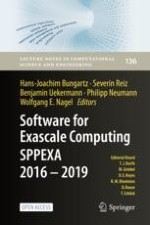A national research project was running in Japan from 2010 to 2017 named “Development of System Software Technologies for Post-Peta Scheme High Performance Computing” (so called Post-Peta CREST) . It was supported by JST (Japan Science and Technology Agency), which is the Japanese counterpart to DFG (“Deutsche Forschungsgemeinschaft”). The Post-Peta CREST project was similar to the first funding phase of SPPEXA in the sense that it had a primarily national scope. Then, the Post-Peta CREST project opened up to international collaboration, and some projects were extended for two more years, where they formed collaborative research groups with SPPEXA phase-II projects. Projects with contributions from Japan are ExaFSA, ExaStencils, EXAMAG, ESSEX-II, EXASOLVERS, AIMES, and MYX, with more than 10 researchers in the second phase of SPPEXA. To highlight the success of the Japanese collaboration with SPPEXA, we have a brief look at two working groups.
Xevolver and ExaFSA
The so-called Xevolver project is one of the Post-Peta CREST projects from 2011 to 2017. A group at the Tohoku University discussed how they could help in legacy code migration to future-generation extreme-scale computing systems that will be massively parallel and heterogeneous. Even today an HPC application code is likely optimized assuming a particular system configuration, and hence specialized only for its target system. In general, such an application is not performance-portable at all. As the HPC system architectures are now diverging and also getting more complicated in terms of accelerators, it will require more time and effort to migrate or re-optimize the code to another system in the future. To make matters worse, system-specific code optimizations are tightly interwoven with the computation and thereby degrade the code readability and maintainability, even though HPC applications need to evolve not only for achieving high performance, but also for advancing computational science. Therefore, in the project, our team has developed a code transformation framework, Xevolver, so that users can define their own code transformations and thus express system-specific code optimizations as code transformation rules. Since code transformation rules can be defined separately from application codes themselves, the Xevolver framework can contribute to separation of system-specific performance concerns from application codes, and hence prevent overcomplicating the codes.
In 2016, core members of the Xevolver research team joined the second phase of the ExaFSA project in order to demonstrate that the Xevolver approach is effective for optimizing real-world applications in practice. The Xevolver approach assumes that an HPC application is developed by a team work of at least two kinds of programmers. One is application developers and the other is performance engineers. Application developers are interested in simulation results rather than performance, while performance engineers are mainly focusing on sustained simulation performance. Therefore, Japanese researchers have worked as performance engineers using Xevolver by considering German research groups as application developers.
The ExaFSA project focused on engineering two solvers, FASTEST and Ateles, which have been developed in the ExaFSA project as primary building blocks of a practical coupled simulation. An incompressible flow solver, FASTEST, has a long history of development and was once optimized for classic vector machines. Thus, some of important kernels still have two versions, default version and its vector-optimized version. In the ExaFSA project, hence, they used the Xevolver framework to express the differences between the two versions, and demonstrated that the vector-optimized version can be generated by transforming the default version. That is, the Xevolver approach can express the system-specific code optimizations as code transformation rules, and thus even simplify the code while achieving high performance and portability. Ateles is based on based on Discontinuous Galerkin (DG) discretization method, and a part of the simulation framework, APES, was developed at the University of Siegen in Germany. Unlike FASTEST, Ateles is written using modern Fortran language features to hide the implementation details. However, the kernel loops still need to be optimized in different ways for individual system architectures to achieve high performance. For example, some loop optimizations with compiler directives are mandatory for the NEC SX-ACE vector computing system to properly vectorize and thus efficiently execute the loops. In this project, Xevolver is used to apply the loop optimizations without major modifications of the original code. Accordingly, the ExaFSA project was a very good opportunity for us to demonstrate that the Xevolver approach can help an appropriate division of labor between application developers and performance engineers by achieving separation of concerns. This clarification of role-sharing will be very helpful for long-term application development especially in an upcoming extreme-scale computing era.
Open Access This chapter is licensed under the terms of the Creative Commons Attribution 4.0 International License (
http://creativecommons.org/licenses/by/4.0/), which permits use, sharing, adaptation, distribution and reproduction in any medium or format, as long as you give appropriate credit to the original author(s) and the source, provide a link to the Creative Commons license and indicate if changes were made.
The images or other third party material in this chapter are included in the chapter's Creative Commons license, unless indicated otherwise in a credit line to the material. If material is not included in the chapter's Creative Commons license and your intended use is not permitted by statutory regulation or exceeds the permitted use, you will need to obtain permission directly from the copyright holder.
